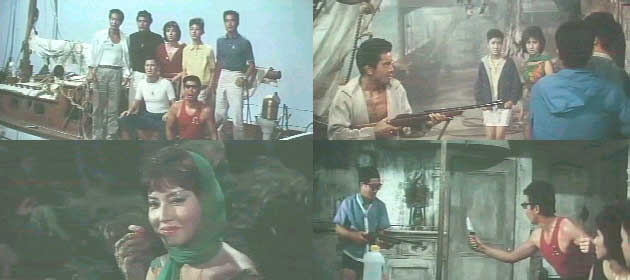Matango (Attack of the Mushroom
People)

Director: Ishiro Honda
Year: 1963
Running Time: 91 minutes
This 1963 film gained something of a bad
film cult reputation after showing up on U.S. late night television in dubbed
form during the sixties and seventies. One thing I think we have learned
from the Celestial releases of the Shaw Brothers movies is that film can
take on an entirely different sensibility when seen (or heard) in its original
language. The dubbing is generally so bad in most of these older films and
so unnatural that it can completely subvert the real purpose of the film and
give it an aura of cheesiness that was simply never there. Certainly that
could be the case with a story in which people turn into giant mushrooms!
But director Ishiro Honda who was behind many of the classic Japanese monster
movies of the time such as Godzilla, Radon, Baran and others used this genre
as a form of sneaky social criticism. This seems to be clearly the case with
this film.

Most obviously the subtext seems pointed at nuclear radioactivity and the
drug culture of the time, but it feels like Honda has an even bigger target
in mind here – Japan and it’s post WWII cultural shift towards Westernization
and consumerism. By 1963 the economic engine that became Japan Inc. was certainly
underway but in doing so Japan also seemed to be discarding many of its traditions
in adopting the ways of the West. In retrospect, this is crystallized at the
very beginning of the film when the camera pans the gaudy neon lit skyline
of Tokyo and moves in on an individual who is asking how this happened and
that no one will believe him. In various flashbacks through the film characters
focus on material things like swank nightclubs and strip clubs full of garish
colors and loose women – signs of Western incursion. The fact that the story
takes place on a small island with few resources is not symbolically lost
either. The mushrooms that they cannot stay away from no matter what the inherent
dangers are more than drugs really – but a lifestyle that is enormously tempting
but self-destructive.

Besides all the subtext in this film, it is also an interesting play on
human nature almost in the same way – though on a much smaller scale - as
Battle Royale. It puts a group of people on an island and basically tasks
them with survival, but in the end this cross-section of society are unable
to work together and it is this inability to co-operate that dooms them to
failure even more than the Mushroom people – man is the real danger
here. Again this can be taken perhaps as a criticism of Japan as a whole.
Throwing all this possible subtext out the window, the film is still rather
an enjoyable if slow watch as the group disintegrates and succumbs to their
desires. People with expectations of rampaging Mushroom people may have their
patience tested, as they don’t actually make an appearance until fairly late
in the film.

Seven friends go out on a yachting getaway - five men and two women – and
a storm comes up and forces them to land on an apparently deserted island.
As they search the island they soon realize that it has no noticeable food
source except these giant mushrooms that they initially stay away from. They
discover a large research boat that has been grounded on the shore, but no
one seems to be alive – and oddly they notice that all the mirrors have been
removed. The find a stash of canned foods that they can survive on for a while,
but soon this begins to dwindle. They begin fighting over food, over authority,
over work details and finally over the two women in their group. Only the
professor (Akira Kubo) – who is narrating the story – seems to be able to
keep his head while the others fall into despair. Eventually the mushrooms
(Matango) become too tempting and one by one they succumb to them – the shot
of the delicious Mami (Kumi Mizuno – who has appeared in many Godzilla films
– even recent ones) biting into them is a great moment of almost sexual release.
Paranoia, egomania and delusions set in and then they begin to understand
in horror why the mirrors were removed.

My rating for this film: 6.0





